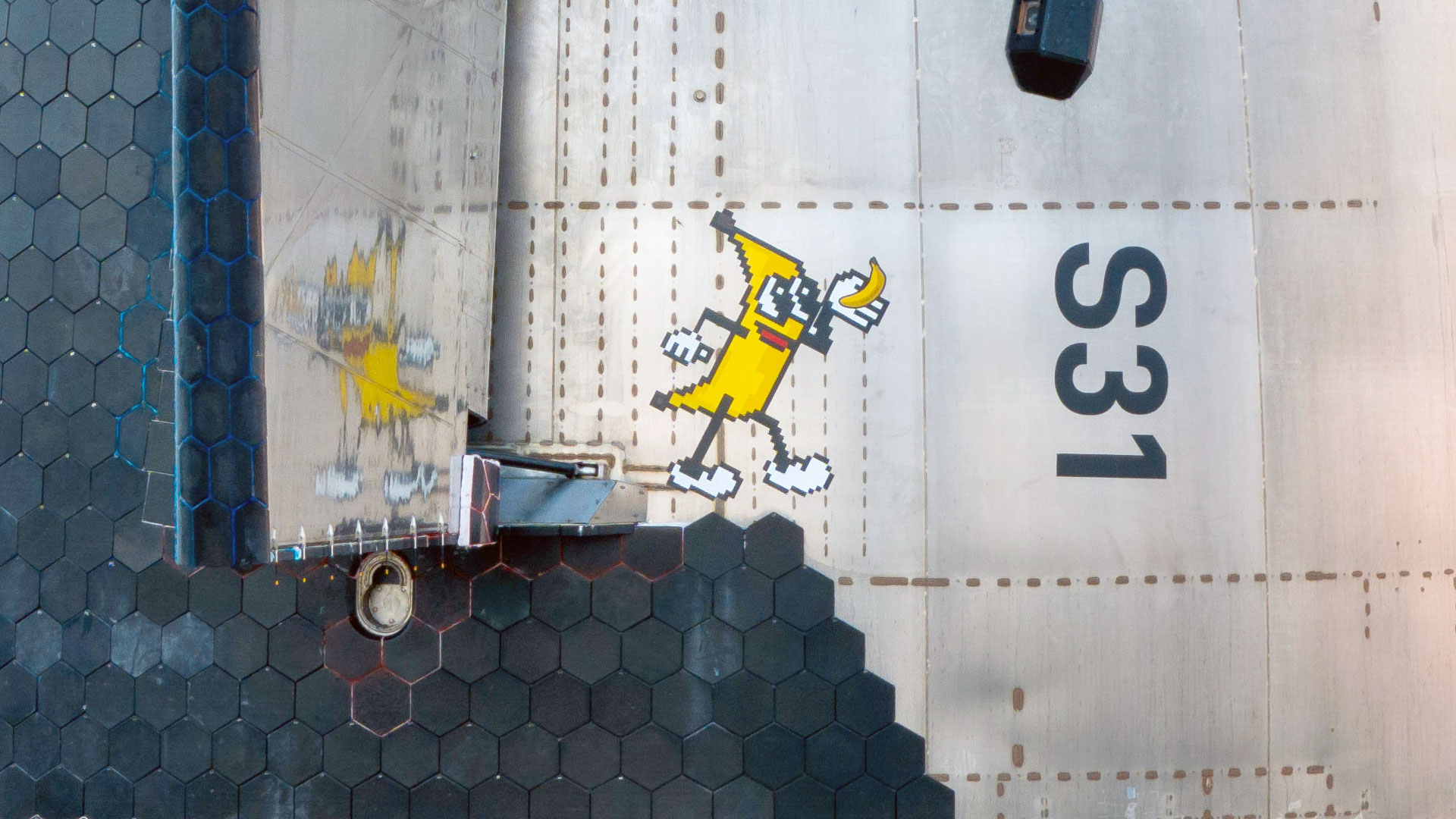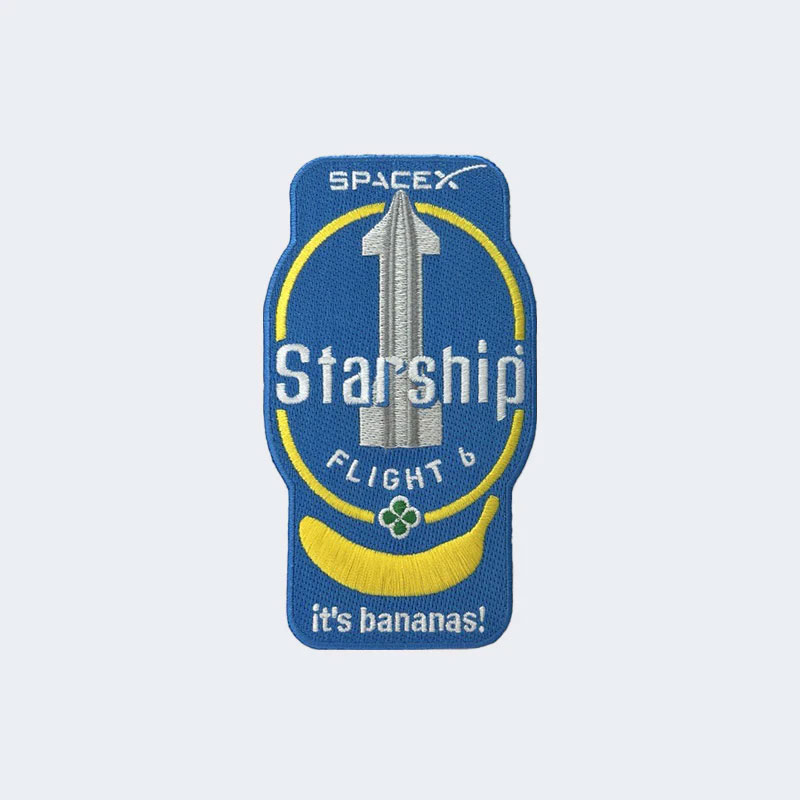'It's bananas:' Toy fruit becomes first zero-g indicator to fly on SpaceX Starship
The banana was also Starship's first physical payload, helping pave the way for Starlink satellites.

An artificial banana floated peacefully in the microgravity environment of outer space on Tuesday (Nov. 19). No longer needing its attached tethers, it just hung there, suspended in the bay of its steel spacecraft's otherwise empty cargo hold.
The fake-but-full-size fruit made history as the first zero-gravity indicator to fly on a SpaceX Starship.
"Bananas have been used for quick visual comparisons for quite some time, and our teammates thought it was time to bring the venerated yellow fruit to Starship," said Kate Tice, a quality engineering manager at SpaceX and co-host of the company's live launch webcast. "Today, we're flying Starship's first-ever physical payload, which is, as you might have guessed, a banana."
A camera mounted in Starship's payload bay revealed the toy banana held by cables tied to its top and bottom. More than just a visual signal that Starship had reached space on its suborbital trajectory, the banana was also a stand-in for gaining the government's approval to begin launching more purposeful payloads on future Starship flights.
"You can see our stuffed banana payload, which is doubling as today's zero gravity or zero-g indicator. And while this payload will remain inside the vehicle at all times and will not be deployed today, it did give us a chance to do a test run of payload approval processes with the FAA [Federal Aviation Administration], and that's something that we're hoping to do next year if we start flying our first Starlink satellites on Starship," said Tice. "Godspeed, banana."
Though hard to see on the in-flight views, if the banana aboard Starship matched the toy that Tice and her co-host, SpaceX manufacturing engineer manager Jessica Anderson, had with them and which are now available to pre-order for $30 through SpaceX's online shop, the 8-inch-long (20 centimeters) yellow fruit has printed on it "(For Scale)." It also bears SpaceX's mission patch for Tuesday's test flight, which is a parody of the blue decal found on Chiquita bananas.
The banana theme extended to the exterior of Starship as well. Affixed to either side of the 165-foot-tall (50 meters) spacecraft were 4-foot-tall (1.2 m) stickers of a pixelated cartoon banana holding an actual-size banana (for scale).
"A single banana is about 1/247 of Starship," read the description on SpaceX's website. The scale includes Super Heavy, Starship's 232-foot-tall (71 m) booster.
Fortunately, Tuesday's test flight — the sixth in SpaceX's series proving Starship is ready to fly to the moon and Mars — did not go bananas. The mission achieved all of its main objectives, including demonstrating that Starship could relight its Raptor rocket engines once in space, a requirement for entering orbit on future launches.
The mission lifted off from SpaceX's Starbase launch facility in south Texas as scheduled at 4:00 p.m. CST (5:00 p.m. EST or 2200 GMT), setting up Starship's first daytime splashdown in the Indian Ocean about 65 minutes later. In the interim, Super Heavy successfully made a soft water landing in the Gulf of Mexico, having been waved off from attempting another tower catch at its launch site, as first achieved on the vehicle's fifth test flight in October.
In addition to its in-space engine test, Starship was outfitted with new secondary thermal protection materials and had sections of its heat shield tiles removed where catch-enabling hardware may be installed on subsequent vehicles. The ship also adopted a higher angle of attack in the final phase of its descent back to Earth, purposefully stressing the limits of its flap control to collect data on future landing profiles.
The flight's "It's Bananas" theme continued two traditions at SpaceX. The company was the first in the U.S. to borrow the Russian custom of flying small toys as zero-g indicators, tracing back to the first human spaceflight in 1961. Beginning with the first flight by a Dragon spacecraft to the International Space Station, SpaceX has launched a menagerie of plush dolls on its crewed missions, including a stuffed planet Earth, an Albert Einstein doll and a small but growing pack of toy dogs.
SpaceX founder and CEO Elon Musk has also made a habit of choosing "odd" items to be the first cargo to fly on each of the company's rockets. On Falcon 9, the first Dragon to fly to and from Earth orbit carried with it a wheel of Le Brouere cheese, a nod to a Monty Python skit. On Falcon Heavy, Musk launched his own Tesla Roadster electric car on a trajectory that took it out beyond the orbit of Mars.
Follow collectSPACE.com on Facebook and on X at @collectSPACE. Copyright 2024 collectSPACE.com. All rights reserved.
Breaking space news, the latest updates on rocket launches, skywatching events and more!

Robert Pearlman is a space historian, journalist and the founder and editor of collectSPACE.com, a daily news publication and community devoted to space history with a particular focus on how and where space exploration intersects with pop culture. Pearlman is also a contributing writer for Space.com and co-author of "Space Stations: The Art, Science, and Reality of Working in Space” published by Smithsonian Books in 2018.
In 2009, he was inducted into the U.S. Space Camp Hall of Fame in Huntsville, Alabama. In 2021, he was honored by the American Astronautical Society with the Ordway Award for Sustained Excellence in Spaceflight History. In 2023, the National Space Club Florida Committee recognized Pearlman with the Kolcum News and Communications Award for excellence in telling the space story along the Space Coast and throughout the world.




